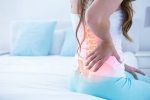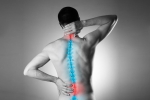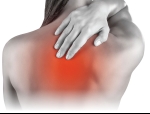Home »
Blog » Back Pain
| Stem Cell, PRP, Acupuncture in Queens & Long Island, New York
Back Pain | Stem Cell, PRP, Acupuncture in Queens & Long Island, New York
Tags: Back Pain | Posted on: 10-Jan-2020 | No of views: 3715 Whether it's a herniated disc, spinal stenosis, or strained muscles, it can take some time to diagnose and treat the causes of back pain. And all the while, you're trying to navigate health insurance, work and family life, and everyday stressors—all while dealing with your back pain. This blog is written to highlight a few fairly simple things you can do to help achieve some level of comfort and pain relief. Here we have some simple tips to help keep your spine as healthy as possible:...
Read more
Tags: Back Pain | Posted on: 06-Jan-2020 | No of views: 3726 Start the Day with Gentle Activity - Slow, gentle activity in the morning can help wake up tired muscles and stiff joints. Just take it easy on your spine, says Raj Rao, MD, professor of Orthopedic Surgery and Neurosurgery at the Medical College of Wisconsin. Deep, relaxed breathing when you wake up may also be helpful. But certain moves aren't recommended if you have back pain -- ask your health care provider what's best for you.
Read more
Tags: Back Pain | Posted on: 03-Jan-2020 | No of views: 3467 It seems you can't watch the evening news or pass by a strip mall without someone trying to sell you a mattress. The seemingly limitless options for choosing a mattress can be overwhelming. This is even truer if you experience back or neck pain—choosing the right or wrong mattress can make the difference between spending the day feeling good or in pain. These 12 tips can't guarantee you will end up with the perfect mattress (since everyone's mattress needs are different), but they can help you make an educated choice.
Read more
Tags: Back Pain | Posted on: 31-Dec-2019 | No of views: 3925 Who's at Risk for Low Back Pain? - Most people experience back pain first when they're in their 30s. The odds of additional attacks increase with age. Other reasons your low back may hurt include: Being overweight, Being sedentary, Lifting heavy stuff on the job, Diagnosing Low Back Pain. To help your doctor diagnose the source of low back pain, be specific in describing the type of pain, when it started, related symptoms, and any history of chronic conditions. Your doctor will probably not need to order X-rays, CT or MRI scans before starting treatment.
Read more
Tags: Back Pain | Posted on: 27-Dec-2019 | No of views: 3638 When you are experiencing low back pain, your first instinct may be to crawl into bed. Until a few decades ago, your doctor probably would have told you to do exactly that. But the tide has turned on our understanding of what is best for tackling back pain, and now the consensus is this: When you have back pain, you should limit or avoid bed rest.
Read more
Tags: Back Pain | Posted on: 26-Dec-2019 | No of views: 5378 Overview - Upper back and neck pain can stop you in your tracks, making it difficult to go about your typical day. The reasons behind this discomfort vary, but they all come down to how we hold ourselves while standing, moving, and most important of all sitting. Neck and upper back pain can limit your movements and capabilities. If you don’t do anything about your pains, they can get worse, spread, and limit you further. This is usually because the muscles around your immediate area of pain have tensed up to protect that one spot. That expansion limits movement and can turn one clenched muscle under your shoulder blade into a painful shoulder and a tension headache.
Read more
Tags: Back Pain | Posted on: 24-Dec-2019 | No of views: 3623 What Is Low Back Pain? - Low back pain is a universal human experience -- almost everyone has it at some point. The lower back, which starts below the ribcage, is called the lumbar region. Pain here can be intense and is one of the top causes of missed work. Fortunately, low back pain often gets better on its own. When it doesn't, there are effective treatments.
Symptoms of Low Back Pain - Symptoms range from a dull ache to a stabbing or shooting sensation. The pain may make it hard to move or stand up straight. Acute back pain comes on suddenly, often after an injury from sports or heavy lifting. Pain that lasts more than three months is considered chronic.
Read more
Tags: Back Pain | Posted on: 20-Dec-2019 | No of views: 3427 Nearly everyone can benefit from massage therapy and its ability to relax muscle tissue and improve blood flow. This may be especially true for chronic patients who rely on frequent treatments from chiropractors or massage therapists. In fact, those with chronic pain may find that they’d like to get more massages, but it's too expensive. With this in mind, we searched for some do-it-yourself ideas and found great examples of how patients with back pain can seek pain relief through do-it-yourself massage techniques. All that’s needed for this DIY massage is a couple of tennis balls, some duct tape, a floor, and no more than 10 to 15 minutes daily.
Read more
Tags: Back Pain | Posted on: 06-Dec-2019 | No of views: 3316 Pain from degenerative disc disease can be debilitating, but you have options. Here are several treatment options and ways to think about managing your degenerative disc disease. Hopefully one or a few of these will work for you. Exercise Relieves Pain - Most people don't associate exercise with pain relief, but when it comes to degenerative disc disease, exercise is an elixir of sorts. It spurs blood flow and builds the supporting structures around the affected disc so that the impact of degeneration is lessened.
Read more
Tags: Back Pain | Posted on: 29-Nov-2019 | No of views: 4048 If you have lumbar spinal stenosis, you may be wondering if playing golf is a good idea. If you've had a spinal stenosis surgery, you may even wonder if golf is possible. The answer for many is yes, but there are a number of considerations to keep in mind. First, recognize that golfing is not really the best thing for your low back. The golf swing imparts a tremendous amount of stress to your lumbar spine. If you are going to return to golf, be willing to accept that there is some risk of injury to the low back.
Read more
Love this Post? Spread the World






















